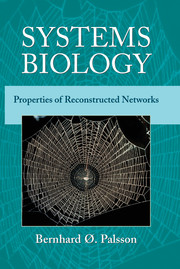Book contents
- Frontmatter
- Contents
- Preface
- 1 Introduction
- 2 Basic Concepts in Systems Biology
- PART I RECONSTRUCTION OF BIOCHEMICAL NETWORKS
- PART II MATHEMATICAL REPRESENTATION OF RECONSTRUCTED NETWORKS
- PART III CAPABILITIES OF RECONSTRUCTED NETWORKS
- APPENDIX A Nomenclature and Abbreviations
- APPENDIX B E. coli Core Metabolic Network
- Bibliography
- Index
PART I - RECONSTRUCTION OF BIOCHEMICAL NETWORKS
Published online by Cambridge University Press: 05 September 2012
- Frontmatter
- Contents
- Preface
- 1 Introduction
- 2 Basic Concepts in Systems Biology
- PART I RECONSTRUCTION OF BIOCHEMICAL NETWORKS
- PART II MATHEMATICAL REPRESENTATION OF RECONSTRUCTED NETWORKS
- PART III CAPABILITIES OF RECONSTRUCTED NETWORKS
- APPENDIX A Nomenclature and Abbreviations
- APPENDIX B E. coli Core Metabolic Network
- Bibliography
- Index
Summary
Cellular functions rely on the interactions of their chemical constituents. Various high-throughput experimental methods allow us now to determine the chemical composition of cells on a genome scale. These methods include whole genome sequencing and annotation (genomics), the measurement of the messenger RNA molecules that are synthesized under a given condition (transcriptomics), the protein abundance, interactions and functional states (proteomics) measurements of the presence and concentration of metabolites (metabolomic), and metabolic fluxes (fluxomics). In addition, methods now exist to determine the binding sites of protein to the DNA (location analysis) and to measure of a limited number of fluxes through reactions inside a cell. The physical location of protein products and segments of the DNA can be determined using various fluorescent reporting molecules. All these methods can be used to help to reconstruct the biochemical reaction networks that operate in cells. This part of the text discusses the reconstruction of metabolic, regulatory, and signaling networks. Given the rate at which new methods are being developed, it is likely that this part of the text will become dated the fastest. However, with new or existing methods the result of the reconstruction process is a set of chemical reactions or interactions that comprise these networks. The reader should be mindful of the fact that these are not separate and independent networks. In fact they interact with one another.
- Type
- Chapter
- Information
- Systems BiologyProperties of Reconstructed Networks, pp. 27 - 28Publisher: Cambridge University PressPrint publication year: 2006



